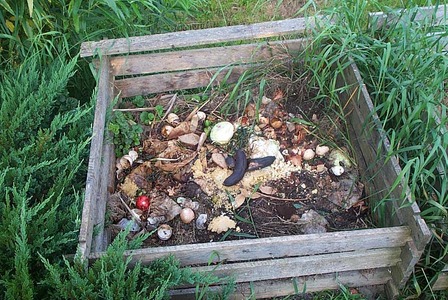Garden Compost: Composting Enriches Soil for Vegetable Gardening

Garden compost is a soil enhancement made up of decomposed vegetable matter, leaves, sticks, grass and even manure. Adding compost to poor soil, such as clay or sand, can turn it into an excellent growing medium. However, it does take a bit of work to create quality compost, or “black gold” as it is referred to by avid gardeners.
Making Compost
To create good compost you need a combination of four primary components: organic matter, water, oxygen and bacteria.
- Organic matter – consists of equal parts green matter and brown matter cut or shredded into smaller bits. Green matter includes lawn clippings, vegetable and fruit peels or rinds. Brown matter consists of dead leaves, sticks, straw or hay, and manure.
- Water – garden compost that is too dry or wet won’t decompose as fast. During dry periods you may need to add water, and during wet periods add extra brown material.
- Oxygen – heat is what decomposes the materials, and oxygen is vital to that process. About every two weeks the compost should be stirred, pulling the matter at the edges of the pile into the center to allow it to also compost.
- Bacteria – the organic matter used all contain bacteria which begin and continue the decomposition and composting process. You might even add a bit of garden soil to your compost to help the process. Once the “baking” is completed, towards the end, then add earthworms.
The Garden Compost Process
Once you’ve got your garden compost pile, or piles, going, then the only effort you’ll need to make is to regularly turn the compost. Using a garden fork or spade, pull the exposed matter from the outer edges to the center, while turning the decomposed center matter to the outside. This allows the heating process to continue with the new matter. Turning should be done about every two weeks, and the entire process takes about three months.
More Than One Pile
Of course, you don’t have to have all your garden compost in loose piles…and if you have chickens, you might not want to do that, as it will soon be scattered all over the place. Some people use bins which stay in place, built or purchased. Just make sure they have slatted walls to allow good air flow. It’s also a good idea to locate the bins in partial shade.
Other types of compost containers include:
Turnable Composters
Either barrel or ball-shaped these units provide good aeration and usually smell better. Once the decomp process has started, it’s important that you don’t add new matter. Unless you are handy, purchasing a compost tumbler can get pricey. However, if you are the least bit handy, you can build a great tumbling, or even rolling, composter out of a plastic drum and some scrap wood.
Portable Composters
Made of plastic that you purchased or formed using T-posts and some chicken wire, the units can then be set up and then moved after the composting process is finished.
Sheet Composting
Really the lazy person’s way of enriching their garden soil, sheet composting should only be done in the fall because it ties up the soil nitrogen. However, this type of composting is just a matter of turning the brown and green matter into the soil and let the process take place of the months when the garden lies fallow.
Trench Composting
This process takes the longest and may not be possible for everyone. However, if you have really poor soil or want to open up a new area to be gardened, dig a trench, bury the organic matter and cover back up. The process takes about a year due to the lack of oxygen, and it also ties up the nitrogen in the soil.
Garden compost can make a world of difference to your soil and is really pretty easy to do. Even if you don’t have the grass clippings or dead leaves, ask your neighbors, on Freecycle or on Craigslist for such organic matter.
With a little preparation anyone can do it.
Return from Garden Compost to Backyard Farming





New! Comments
Have your say about what you just read! Leave me a comment in the box below.